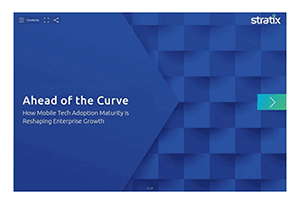Staving off Culture Shock: How the Android Enterprise Recommended Ecosystem Can Help Spur Enterprise Tech Innovation
Written by Sandra Tansky
2 Min Read
Blog
What does it mean to have a true company culture? Ostensibly, it embodies the personality, mission and goals of your organization. Your company culture, however, informs more than your broadest objectives or what type of work environment your employees enjoy. Your culture is a huge determining factor in your day-to-day tactics as well.
In our ongoing blog series based on our whitepaper, Ahead of the Curve: How Mobile Tech Adoption Maturity is Reshaping Enterprise Growth, we’ve previously discussed how mobile tech maturity impacts tech adoption and key steps you can take to improve it as well as a checklist to help you get the most from your managed mobile services provider. This final installment shifts our focus to the differences in culture between our previously established categories of IT decision makers:
- Innovators
- Early Adopters
- Early Majority
- Late Majority and Laggards
The Innovators set themselves apart in how they follow technology closely, work with providers to understand it definitively, and position their organizational capabilities to pounce exactly when the technology is stable. This, however, begs the question as to why they are uniquely positioned to do these things.
The answer is simple: What they do is informed by their culture.
When we look at the data presented in the whitepaper, we see that Innovators led in identifying organizational capabilities (Internal IT teams, IT Service partners) as the biggest barriers to tech adoption (and the ensuing tech maturity). But they also stand alone as the only group that prioritized partnering with other Innovators or start-ups to prepare against disruption. The other groups either opted for acquiring disruptive companies when possible or took to a Do-It-Yourself (DIY) tact when deploying technology to prepare against disruption.
In short, Innovators are the first to realize they derive organizational strength in the breadth and width of their partnerships. The epitome of this is their engagement with fully-realized and forward-looking entities such as Google’s Android Enterprise Recommended (AER) ecosystem. This strategic alignment allows partner certified Android Enterprise specialists to engage Google engineers directly, deliver faster critical updates and – most importantly – deploy Android smartphones and tablets in bulk and ready for usage out-of-the-box, by leveraging AER managed service providers.
Innovators also stand alone in how they prioritize engaging tech partners (e.g. managed mobile services) that not only can help them leverage extensive partnerships, but also possess experience in their specific industry or vertical market. These partnerships are key to their agility, and thus what helps make them so, well……innovative in the first place.
To determine your organization’s mobile maturity, take this two-minute assessment.

Mobile Tech Adoption Maturity
Learn what the key drivers of technology adoption readiness are and how to benchmark your digital transformation initiatives.
Read More












